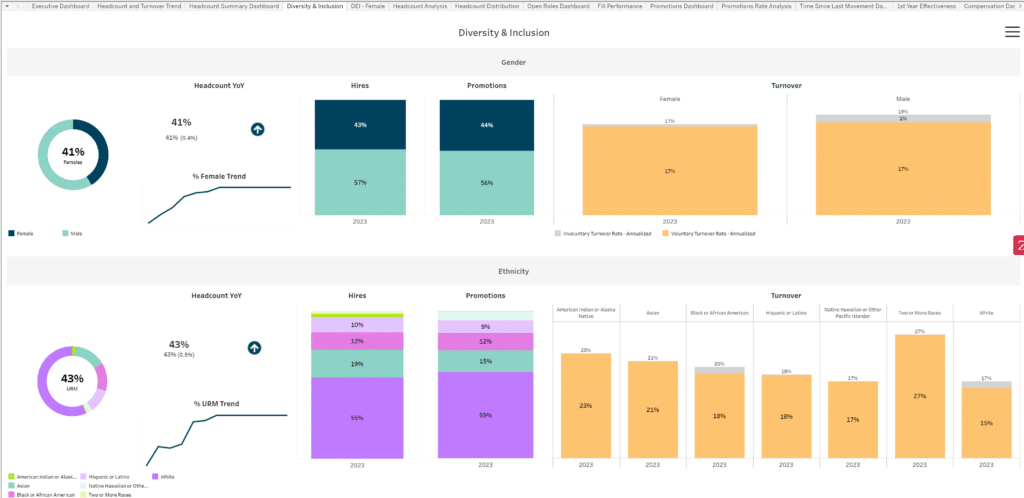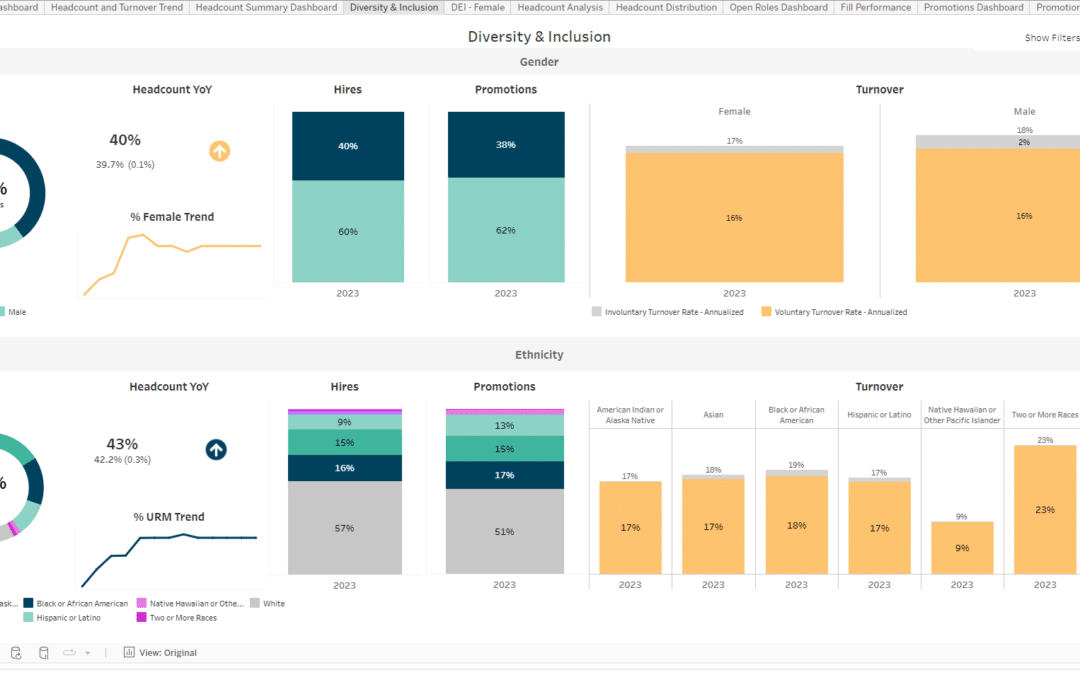Maximizing Diversity, Equity, and Inclusion (DEI) Programs: The Role of HR Analytics
In the last few years, “diversity, equity, and inclusion” has become a collective buzzword in many corporate HR circles. But despite the term’s ubiquity, it’s important to realize that DEI programs and strategies are more than just the latest corporate trend. They represent a solution to an issue that affects businesses of all sizes on every level.
The True Power of DEI
Inclusion helps foster a sense of psychological safety in the workplace, empowering employees to feel comfortable being themselves. This psychological safety in turn produces better employee engagement — 66% of highly engaged employees reported feeling comfortable being their authentic selves at work, a key indicator of an inclusive workplace culture. 65% of highly engaged employees also report feeling respected in the workplace, and 73% report feeling a sense of belonging and value.
Furthermore, the increased engagement that results from a diverse and safe workplace can decrease turnover by as much as 43%, increase productivity by 18%, and increase business profitability by 23%.
Finally, diverse corporations can also achieve tangible benefits as a result of their DEI efforts. Businesses in the top quartile for gender and ethnic diversity in leadership outperform their fourth quartile peers by as much as 36%. Highly diverse companies are also 45% more likely to report increased market share and 70% more likely to report capturing a new market.
However, businesses must realize that DEI programs must be well-structured to be effective. Generally, there are three key components to good DEI programming:
- Employee resource groups (ERGs)
- Leadership commitment
- Training and education
And even though it is not often considered to be a component in and of itself, HR analytics plays a pivotal role in optimizing the success of all three of these components. The data you collect regarding each will tell you whether you are garnering the results you want to see.
Get our 2024 Guide to People Analytics
Employee Resource Groups (ERGs)
In simplest terms, an ERG is a gathering of employees who share the same background or interests, whether that’s a hobby like running or crafting or a common interest like volunteering at local organizations.
When it comes to DEI initiatives, the purpose of an ERG is to gather people of similar ethnic backgrounds to form supportive communities. Doing so allows employees to share their experiences, find mentors and resources for professional growth, and discover a sense of belonging at work.
If you’re considering implementing ERGs as part of your DEI efforts, you can use HR analytics software to help you assess their effectiveness and impact on fostering a sense of belonging and inclusivity among your diverse workforce. Analytics is a great means of measuring ERG engagement levels so you can understand membership demographics and participation rates. After all, ERGs can only be effective if employees are participating in them.
But even if you find that your employees aren’t engaging, you’ll be able to ask deeper questions to determine why that is and assess whether these groups need better marketing, a more effective structure, more empathetic leadership, or something else altogether. Analyzing feedback and employee sentiment can help you understand exactly what your ERGs need to be more effective. Perhaps a group has been hosting roundtables when what group members truly want is mentorship. Going into your feedback can help you identify and correct issues like these and subsequently ensure that these groups are meaningful to the people they are meant to help.
Finally, it’s important to leverage analytics to track the influence of ERGs on organizational culture and employee engagement. In order for your DEI initiatives to be deemed successful, the benefits they provide should translate to the overall workforce. Tracking the right analytics ensures that every employee feels welcome across the organization, not just when they’re meeting with their ERG.
Although ERGs are a major undertaking, many corporations wholeheartedly believe in their efficacy. For example, Walmart, which ranks consistently among the top 50 companies regarding diversity, has implemented several ERGs as part of its DEI strategy. These include the African American Business Resource Group, the Asian Pacific Associates Network, inABLE (for those interested in increasing accessibility), and PRIDE (for the LGBTQ community and its allies).
Leadership Commitment
Your ERGs and other DEI efforts will ultimately depend on the level of leadership buy-in in your company. Without the support of those at the top, you may find it hard to make or keep DEI programs a top priority, especially in lean times.
Fortunately, HR analytics can assist in this regard as well. Analytics software can help you evaluate diversity metrics at the leadership level, showing how much representation and inclusion different groups have in the decision-making process. That is critical to ensuring that leadership teams are able to make decisions that take everyone’s needs into account.
Additionally, HR analytics can help you measure and analyze employee sentiment and perception of company leadership. How committed leadership thinks they are to your DEI initiatives means nothing if your employees aren’t able to experience the tangible benefits of that commitment.
You’ll know your DEI efforts are working when employees can identify concrete ways through which they have improved their experiences. You can also approach diversity analytics and track progress by way of diversity scorecards, which are a simple way to foster transparency and accountability with your workforce and the general public.
Two examples of companies with excellent leadership buy-in are Heineken and IKEA. Both have significantly increased the representation of women in leadership roles, with Heineken experiencing a 10% increase in just two years and IKEA having 48% of its country-wide CEO positions and 50.2% of all manager positions occupied by women.
Training & Education
Training and education are the last (though certainly not the least) crucial aspects of a successful DEI program. It’s important that companies not assume that their workforce will understand how to embrace DEI initiatives from the onset. Training and education are often necessary to promote awareness, empathy, and cultural competence, especially where unconscious biases are concerned.
Undoubtedly, incorporating HR analytics into your training and education efforts can enhance their effectiveness. For example, assessing training completion rates and teaching about retention can help you identify ways in which you can make the training clearer or more likely to encourage and ensure employee participation.
Above all else, two aspects will always remain vital: ensuring your entire workforce is represented in your training and that you are providing useful information they can leverage to contribute positively to workplace culture. As such, it’s also a good idea to analyze your employee demographic data, as doing so will help you tailor your content and your delivery method to diverse employee groups. You can also use predictive analytics to predict training needs and proactively respond to any gaps.
Johnson & Johnson is one company that is doing things well when it comes to training and education. The company not only has leadership buy-in, as its Chief Diversity Officer reports to top-level management, but it also provides unconscious bias training for all employees.
Similarly, Ernst & Young introduced their Inclusive Leadership culture change program in 2021, which highlights unconscious bias and the principles of inclusion through web-based learning.
HR Analytics Can Be the Missing Key to Effective DEI
DEI initiatives benefit companies in many ways. But in order to reap those benefits, companies must provide their employees with opportunities to convene with and learn from those with similar backgrounds. That is accomplished through ERGs, diverse representation, buy-in from leadership teams, and those teams’ commitment to providing employees with training and education that fosters awareness and inclusivity.
HR analytics plays a pivotal role in all of this. It can optimize the impact of DEI initiatives by providing leadership teams with assessment and feedback data, which will help them understand whether their efforts are meeting employees’ needs and fostering long-lasting change. Because DEI touches all aspects of a workforce – from hiring strategy, to employee engagement and satisfaction, to performance ratings and compensation equity – using an HR analytics tool to aggregate and connect the dots between disparate people data sets is critical to getting a holistic view of the impact of your company’s DEI strategy.

DEI Metric Dashboard
Whether you’re just starting a DEI initiative or want to increase the effectiveness of the one you already have, leverage HR analytics as a strategic tool to advance your commitment to DEI in the workplace. Not only will doing so enhance your employer brand and business performance, but you’ll also be able to take pride in the fact that your business is a place where all employees are welcome, supported, and given the tools they need to succeed.
Looking for an HR analytics solution to help you measure and optimize your DEI efforts? Learn more about PeopleInsight by HireRoad.

